- Clone
- 4.24.1 (See other available formats)
- Regulatory Status
- RUO
- Other Names
- PVR (poliovirus receptor) homolog
- Isotype
- Rat IgG2a, κ
- Ave. Rating
- Submit a Review
- Product Citations
- 6 publications
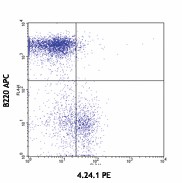
| Cat # | Size | Price | Quantity Check Availability | Save | ||
|---|---|---|---|---|---|---|
| 132205 | 25 µg | £97 | ||||
| 132206 | 100 µg | £234 | ||||
Mouse CD155, also known as homolog of polivirus receptor, is the founding member of a subfamily of immunoglobulin-like adhesion receptors (nectins). Mouse CD155 is expressed on a wide variety of cells of hematopoietic origin apart from its existence on the epithelial cells. The engagement of CD155 with CD226 and CD96 induces cytotoxicity of NK cells and CTL.
Product DetailsProduct Details
- Verified Reactivity
- Mouse
- Antibody Type
- Monoclonal
- Host Species
- Rat
- Immunogen
- EL4 transfected with mouse CD155
- Formulation
- Phosphate-buffered solution, pH 7.2, containing 0.09% sodium azide.
- Preparation
- The antibody was purified by affinity chromatography, and conjugated with PE under optimal conditions.
- Concentration
- 0.2 mg/ml
- Storage & Handling
- The antibody solution should be stored undiluted between 2°C and 8°C, and protected from prolonged exposure to light. Do not freeze.
- Application
-
FC - Quality tested
- Recommended Usage
-
Each lot of this antibody is quality control tested by immunofluorescent staining with flow cytometric analysis. For flow cytometric staining, the suggested use of this reagent is ≤ 0.25 µg per 106 cells in 100 µl volume. It is recommended that the reagent be titrated for optimal performance for each application.
- Excitation Laser
-
Blue Laser (488 nm)
Green Laser (532 nm)/Yellow-Green Laser (561 nm)
-
Application References
(PubMed link indicates BioLegend citation) -
- Tahara-Hanaoka S, et al. 2004. Int Immunol 16:533
- Maier MK, et al. 2007. Eur J. Immunol. 37:2214
- Bottino C, et al. 2003. J. Exp. Med. 198:557
- Chan CJ, et al. 2010. J. Immunol. 184;902. PubMed
- Product Citations
-
- RRID
-
AB_1279105 (BioLegend Cat. No. 132205)
AB_1279103 (BioLegend Cat. No. 132206)
Antigen Details
- Structure
- 70 kd immunoglobulin-like molecule with three Ig-like domains.
- Distribution
-
CD155 is expressed at cell junctions on the primary vascular endothelial cells. Moreover, mouse CD155 is highly expressed on DP thymocytes and expression level is dropped in peripheral single positive CD4+ and CD8+ T cells. CD155 can be detected on T reg, other activated T cells and on NKT cells. Resident monocytes express moderate amount of CD155, but upregulated its expression during inflammation. Other cells, such as IEL, neutrophils and subsets of B cells were found to express CD155 to varying extents.
- Function
- Apart from its function of adhering junction among contacting epithelial cells, the interaction of DNAM-1 (CD226) with its ligands CD155 and CD112 (nectin 2) induces cytotoxcity of NK cells and CD8+ T cells and cytokine secretion.
- Ligand/Receptor
- CD226 (DNAM-1), CD96
- Cell Type
- B cells, Monocytes, Neutrophils, T cells, Thymocytes, Tregs
- Biology Area
- Immunology, Innate Immunity
- Molecular Family
- Adhesion Molecules, CD Molecules, Immune Checkpoint Receptors
- Antigen References
-
1. Mendelsohn C et al. 1989. Cell 56:855
- Gene ID
- 52118 View all products for this Gene ID
- UniProt
- View information about CD155 on UniProt.org
Related Pages & Pathways
Pages
Related FAQs
- What type of PE do you use in your conjugates?
- We use R-PE in our conjugates.
Other Formats
View All CD155 Reagents Request Custom Conjugation| Description | Clone | Applications |
|---|---|---|
| Purified anti-mouse CD155 (PVR) | 4.24.1 | FC |
| PE anti-mouse CD155 (PVR) | 4.24.1 | FC |
Customers Also Purchased
Compare Data Across All Formats
This data display is provided for general comparisons between formats.
Your actual data may vary due to variations in samples, target cells, instruments and their settings, staining conditions, and other factors.
If you need assistance with selecting the best format contact our expert technical support team.
-
Purified anti-mouse CD155 (PVR)
-
PE anti-mouse CD155 (PVR)
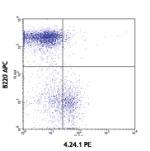
C57BL/6 splenocytes stained with RA3-6B2 (B220) APC and 4.24...

 Login / Register
Login / Register 











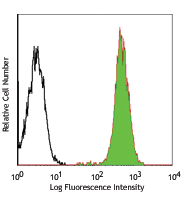
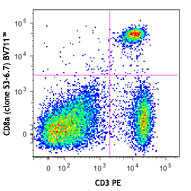

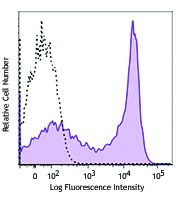







Follow Us